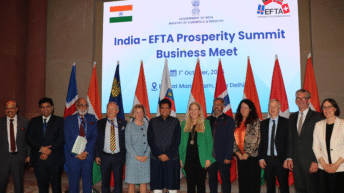
High up in the Himalayas, faith intersects with the fragility of nature and livelihoods. Kedarnath, located at nearly 11,755 feet in Uttarakhand’s Rudraprayag district, is a pivotal site in the Char Dham Yatra, an important Hindu pilgrimage circuit. Accessible only from May to October due to harsh winter conditions, according to the Hindu calendar it opens on Akshaya Tritiya and closes on Devutthani Ekadashi, Kedarnath attracts hundreds of thousands of pilgrims annually. They undertake a challenging climb by foot, mule, or helicopter. This seasonal influx brings to the quiet high-altitude village a bustling economy dependent on pilgrimage.
For locals porters, guides, dharmshala managers, mule owners, tea sellers, and souvenir vendors the rhythm of life is dictated by the temple bell; when the pilgrimage stops, so does their income. The pilgrimage’s economic impact is extensive, creating various jobs and employment opportunities. Residents serve as porters transporting supplies, pony operators assisting trekkers, guides for religious sites, and staff in eateries and shops. The hospitality sector thrives due to ancestrally-connected dharmshalas, homestays, guest houses, and hotels catering to different income levels. Additionally, numerous micro-businesses, such as religious souvenir shops, tea stalls, trekking equipment rentals, and vendors of rain gear and woollens, form the backbone of the local economy.
This article is based on my six-day visit to Uttarakhand (Haridwar, Rishikesh, Rudraprayag, and Badrinath) from 4th to 9th May 2024. I met 15 local vendors and did open-ended interviews. All the interviews were conducted at Kedarnath trek and Gouri Kund, because these places are most affected when the temple gates are closed. The interviews are takes 10-12 minutes each, starting from the bases information like how long they are serving? do they have another source of income? How many household members are dependent on them? Did anyone in their families migrate in the last 5 years? How many members of the family are involved in this business? Do they come from outside of the Sonprayag district?
The Harsh Reality of Seasonal Dependency
Kedarnath Temple, one of the holiest shrines of Hinduism and a part of the Char Dham Yatra, remains accessible only for seven months. The remaining months are marked by heavy snowfall and treacherous weather, forcing a complete halt to both travel and commercial activity. While the brief yatra season attracts an influx of economic activity, the region’s dependence on seasonal religious tourism results in a cyclical boom-and-bust pattern.
According to the Uttarakhand Tourism Development Board (UTDB), over 1.9 million pilgrims visited Kedarnath in 2023 during its operational months (UTDB, 2023); this year the number of visitors has crossed 16.52 lakh, in the two weeks before the temple’s doors closed. For the remaining seven months, the community is deserted, shopfronts are shuttered, and the livelihoods of thousands of people are suspended.
Livelihoods at Risk
The socio-economic impact of this seasonality is significant. Pant et al. (2018), in their study of tourism economies in the Himalaya, reported that in this Himalayan region more than 70 percent of households survive only on pilgrimage-related income over the summer months. A sudden drop in pilgrim numbers due to weather disruptions (like the Kedarnath disaster of 2013), health emergencies, or global shocks like COVID-19 can devastate household economies.
In the case of Kedarnath, significant stakeholders are: Porters and Mule Operators who carry goods and older or ill pilgrims up the longer 16-km trek; small Business Owners; Local shops selling prasad, woollens, rain gear, and religious items; Hospitality Providers such as Dharmshalas, guest houses, and campsites operated by local families; and owners and workers in Transport and Logistics: helicopter operators, horse renters, and food vendors. The seasonal nature of income not only creates cash flow issues but also limits access to credit, insurance, and long-term investment opportunities. Many families are forced to migrate temporarily to cities like Rishikesh or Dehradun during the off-season to work as labourers or in informal retail (Sharma & Nautiyal, 2020).
Climate, Crisis, and Instability
Kedarnath’s extreme vulnerability was exposed in the 2013 flash floods, which killed over 5,000 people and washed away much of the town’s infrastructure. Even a decade later, the scars of that disaster remain. Climate change, increasing the frequency of glacial lake outburst floods (GLOFs), landslides, and erratic rainfall, add another layer of unpredictability to the seasonal economy (Dobhal et al., 2013). Moreover, extreme cold conditions and inadequate year-round infrastructure discourage any form of winter tourism. In contrast to the emerging ski and snow-tourism destinations of Auli or Manali, Kedarnath is constrained by nature and policy.
What Can Be Done? Toward Sustainable Livelihoods
To mitigate economic vulnerabilities, experts and policymakers should widen their frame of reference beyond the pilgrimage season and seek to put in place sustainable and year-round livelihood models:
1. Promotion of Winter Religious Tourism and Eco-Tourism
In order to reduce economic vulnerability, experts and policymakers need to extend the pilgrimage season to design sustainable, year-round livelihood strategies. One approach is the introduction of winter religious tourism and eco-tourism initiatives. Alternative short-term attractions can be established in the nearby, lower-altitude areas, such as Guptkashi and Ukhimath, for spiritual retreats and yoga camps during the winter. Many different types of eco-sensitive tourism initiatives can be established to attract visitors during other periods of the year. Research has established that diversifying religious tourism across the seasons serves the local economy and ensures cultural continuity (Rahmati & Rajabi, 2021).
2. Skill Development and Craft Revitalization
Another significant area is skill building and craft revival. Promoting training in traditional handicrafts, wool weaving, and sustainable product packaging for pilgrims can create jobs at the local level. Online platforms can be established to allow local artisans to sell their products throughout the year, which helps to further their market reach and lessens the reliance on seasonal tourists (Sharma, 2022).. That is essential for the preservation of traditional crafts, while maintaining some relation to the reality of the current market (Maitra & Schwecke, 2026).
3. Disaster-Resilient Infrastructure
It is equally essential to invest in disaster-resilient infrastructure. Improving road and internet connectivity in lower-altitude villages would allow them to host tourists when Kedarnath is shut down. Furthermore, constructing all-weather shelters and storage facilities enables small businesses to safely store goods and operate year-round. When delays and diversions are caused by disasters or other events, the community can more easily cope with the loss of tourism and livelihoods, if disaster risk management is integrated with local planning (He & Cha, 2021).
4. Social Security Nets
An additional important action involves improving social safety nets for seasonal workers. Access to programs such as PM Vishwakarma Yojana, e-SHRAM, and Ayushman Bharat schemes will guarantee income and health security for families and dependents who earn an income from the tourism industry. Cooperative institutions and rural banks in particular will be critical entitlements for these workers and will strengthen local economies through financial inclusion and welfare programs (Panakaje et al., 2024).
5. Local Cooperatives and Credit Access
Ultimately, throughout the region, the promotion of local cooperatives and access to credit can empower communities economically. Building the capacity of self-help groups (SHGs) and cooperative societies allows for greater collective bargaining power, easier access to financial support, and facilities for joint marketing of locally available products and services. There is evidence that cooperative models are effective mechanisms for sustainable socio-economic development in rural areas (Fernandez-Guadaño et al., 2020).
Collectively, these approaches will transform the regional economy from one that is almost entirely seasonal to one that is more stable, resilient, and equitable. Kedarnath’s spiritual magnetism drives a significant seasonal economy, but the long months of economic inactivity leave thousands in a vulnerable state. When the bells of the temple fall silent in October, so too do the cash registers of the mountain people, frozen in a long winter of financial uncertainty.
It is essential to rethink pilgrimage tourism as an opportunity for sustainable development rather than a seasonal windfall. Faith may be eternal, but income need not be seasonal.
References
Dobhal, D. P., et al. (2013). Kedarnath disaster: A hydrometeorological perspective. Current Science, 105(2), 171-174.
Fernandez-Guadaño, J., Lopez-Millan, M., & Sarria-Pedroza, J. (2020). Cooperative Entrepreneurship model for sustainable development. Sustainability, 12(13), 5462. https://doi.org/10.3390/su12135462
He, X., & Cha, E. J. (2021). State of the research on disaster risk management of interdependent infrastructure systems for community resilience planning. Sustainable & Resilient Infrastructure, 7(5), 391–420. https://doi.org/10.1080/23789689.2020.1871541
Maitra, S., & Schwecke, S. (Eds.). (2026). Crafting India’s skill ecology: Reproductions, recalibrations, and reimaginations. Routledge. (Pre-Print)
Pant, M., Rawat, G. S., & Kumar, P. (2018). Tourism and Livelihoods in the Himalayas: A Socio-Economic Analysis. Mountain Research and Development.
Panakaje, N., Ur Rahiman, H., Parvin, S. M. R., & Rabbani, A. S. (2024). Revitalising socio-economic empowerment through cooperative banks: Insights from India. Arab Gulf Journal of Scientific Research, 42(4), 1456–1471. https://doi.org/10.1108/agjsr-05-2023-0188
Rahmati, S. M., & Rajabi, M. (2021). On the effect of religious tourism on spiritual health and culture. International Journal of Tourism, Culture and Spirituality, 5(2).
Sharma, N. & Nautiyal, M. (2020). Livelihood Vulnerabilities in the Garhwal Himalayas: A Case Study of Kedarnath. Journal of Mountain Science.
Sharma, K. (2022). E-commerce and Handicraft Integration in Rural Tourism. Ministry of MSME Policy Brief.
Uttarakhand Tourism Development Board (2023). Char Dham Yatra Report 2023. Retrieved from https://uttarakhandtourism.gov.in






Add comment